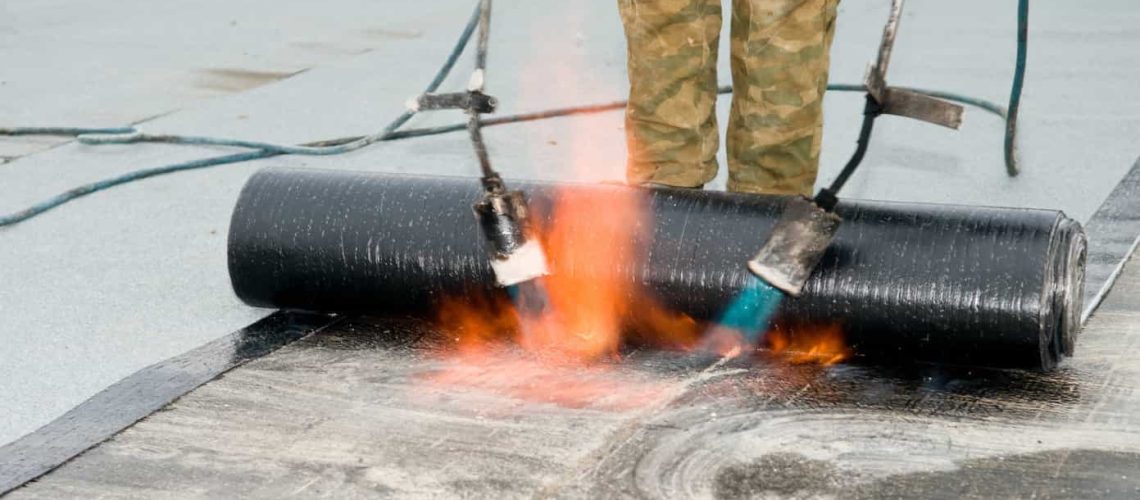Tar and gravel roofing is intended for commercial buildings with flat or low slope roof. Roofing contractors prefer to use gravel on flat roofing because of its ability to protect the built-up roofs’ underlying layers of materials and keep them secure.
Tar and Gravel Roofs-In A Nutshell
Tar and gravel roofs – also referred to as built-up roofs (BURs) – are assembled using alternating layers of roofing fiberglass or felt. It is combined with asphalt which is applied with heat to make the roofing material more durable. BURs are considered as a popular type of flat roof because of these combined materials. Another standout quality of BURs is that it can withstand all sorts of elements like heavy rains, hailstorms, and ultraviolet rays.
BURs are composed of layers of gravel which is embedded on the asphalt top-coat. The gravel serves as the primary protection of this roofing system. The weight and type of gravel will depend on various factors like the climate, the building’s structure, and the underlying layers. While the asphalt itself can provide sufficient protection against harsh weather by waterproofing the roof, the gravel provides additional protection, thus allowing your roof to remain undamaged for years.
Reasons To Install a Tar and Gravel Roofing System
There are numerous benefits you can reap from installing a tar and gravel roofing system. Aside from its long lifespan, which can last up to 25 years depending on the structure and location of your property, the gravel’s weatherproofing aspect also proves that it is impervious to all sorts of wear and tear.
What Are the Types of Tar and Gravel Roofs to Consider?
When choosing the tar and gravel roofing system, there are two main types for you to choose from: modified bitumen roofs and ballast roofing. Each type has its own advantage. The modified bitumen roofs are made up of a mix of rubber and asphalt and it has gravel top layer. The ballast roofing, on the other hand, has larger gravel, which also serves as the single ply roofing system’s top layer.
Modified Bitumen Roofs
This type of tar and gravel roofing system can be built using a variety of modifiers to increase the strength and durability of this roofing system. Styrene-butadiene-styrene (SBS) and atactic polypropylene (APP) are the two most common modifiers that are added to bitumen roofs.
SBS is known for improving the roofing membrane’s flexibility so it will have contraction capabilities and stronger expansion. APP has its own merits by ensuring that your roofing system stays durable and strong in the years to come.
Making a choice might give you a hard time because both options have been proven to be popular in different applications and climates. If you are not sure what to choose, a roofing contractor will help you make an informed decision.
There are many reasons to consider a modified bitumen roof and one of which is that it can improve water evaporation because of the ability of gravel to hold and release heat. With this advantage, the underlying layers of your roof will be free from heat and moisture.
It is important to note that the gravel on modified bitumen must remain loose and even to prevent punctures caused by foot traffic.
Ballast Tar and Gravel Roofs
If your commercial building is located in an area where there is an abundant source of ballast, ballast roofing is a great choice. Ballast is a number one choice for roofs made of tar and gravel roof alternatives like ethylene propylene diene monomer (EPDM), thermoplastic polyolefin (TPO), and polyvinyl chloride (PVC) single-ply flat roofs.
Ballast roofing offers numerous advantages because of its sustainability, fire resistance, and durability. The ballast stones are not embedded in the roofs’ membrane which is why you can remove them easily when repairing the membrane. It is also an energy-efficient roofing system, making it a popular choice in many locations.
Tar and Gravel Roof Maintenance Requirements
You can enjoy the benefits of tar and gravel roofs for decades if it is properly installed. One way that you can strengthen this roofing system is by adding more layers to the existing roofing materials. Some popular options will be adding foam or fiberglass to improve the roofs’ insulation. If you want to weatherproof your flat roof, applying elastomeric or new acrylic can make a huge difference.
Repairing Tar and Gravel Roofs
When it comes to repairing tar and gravel roof, going the DIY path is not a good idea. This job is better left to the roofing experts because it is a complicated process. If your BUR roofing system is properly maintained, you can expect it to last for decades and the possibility of repair might not be as frequent as you thought it to be.
If you notice leaks or damage to your roofing system, the contractor will patch the membranes of your roofing system. When evaluating a commercial property with a tar and gravel roofing system, the leaks are an indication of weak areas and past leaks. If this is the case, you need to consult a building inspector or roofing contractor before you consider buying a new property.
The patches that are not done professionally may cause the roofs to leak again, especially in areas where natural disasters like floods, hurricanes, and hailstorms are common. Experts often recommend replacement if 25% of the roof has been covered in patches. Another way to test the roofing system’s durability is by walking on the roof yourself. It is one way to tell if it can withstand foot traffic.
Tar and gravel roofing systems with depressions, discoloration, blistering, loose area and other damaged surfaces are indications that you need to replace them as soon as possible.
When You Should Not Install Built-up Roofs
Although tar and gravel roofing systems offer numerous benefits, there are areas where this type of roof should not be installed. For areas with extreme sun exposure, your tar and gravel roof might experience damage, especially when the gravel does not evenly cover the roofing materials.
It is not also suitable for properties in areas experiencing large amounts of rain or snow. Your roofing system can be damaged due to extreme precipitation, making it more prone to leaks. Flat roofing is vulnerable to ponding, a term used when water pools on the surface of the flat roofing for more than 48 hours. When it forms a pond, the water increases the weight on your roof.
Ponding can affect the overall structure of your roof and can make plenty of room for all types of damage including depression. The roof’s surface can also become breeding ground for mold and mildew when ponding or pooling continues. In no time, your roof will begin to deteriorate. Although an adequate drainage system is one way to prevent ponding, roofing experts do not recommend this if there are high levels of rain or snow.
Add Layers of Protection to Your Roofing System
Regardless of the type of roofing system you consider, securing proper documentation is necessary. Be sure to keep a record of your roof’s condition and keep your documentation updated. In the event that a natural disaster happens, you have proof of your roofing system’s condition before the disaster took place. It will be easier for you to make an insurance claim if you get everything documented.
Without doubt, new roof installation is an investment, especially when installing tar and gravel roofs. It requires regular maintenance to extend its life for decades. By working with a public adjuster, you will be able to address your concerns regarding tar and gravel roofing installation.





